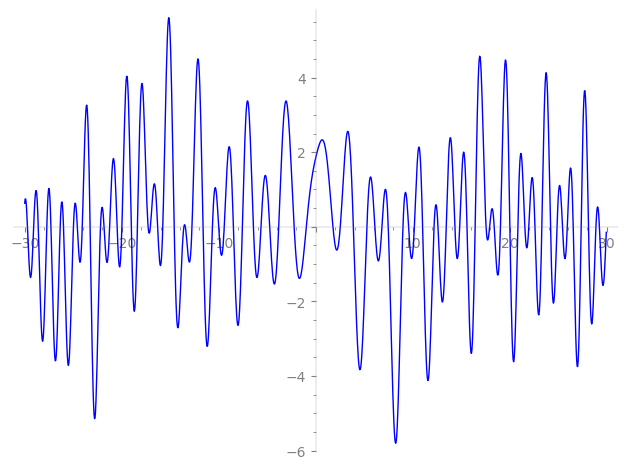| L(s) = 1 | + (−0.145 + 0.448i)3-s + (2.86 − 2.07i)5-s + (−0.710 − 2.18i)7-s + (2.24 + 1.63i)9-s + (0.309 − 3.30i)11-s + (−0.616 − 0.448i)13-s + (0.515 + 1.58i)15-s + (−0.815 + 0.592i)17-s + (0.309 − 0.951i)19-s + 1.08·21-s − 2.94·23-s + (2.32 − 7.14i)25-s + (−2.20 + 1.60i)27-s + (−1.55 − 4.79i)29-s + (−2.67 − 1.94i)31-s + ⋯ |
| L(s) = 1 | + (−0.0840 + 0.258i)3-s + (1.27 − 0.929i)5-s + (−0.268 − 0.826i)7-s + (0.749 + 0.544i)9-s + (0.0931 − 0.995i)11-s + (−0.171 − 0.124i)13-s + (0.132 + 0.409i)15-s + (−0.197 + 0.143i)17-s + (0.0708 − 0.218i)19-s + 0.236·21-s − 0.615·23-s + (0.464 − 1.42i)25-s + (−0.423 + 0.307i)27-s + (−0.289 − 0.890i)29-s + (−0.480 − 0.348i)31-s + ⋯ |
Λ(s)=(=(836s/2ΓC(s)L(s)(0.530+0.847i)Λ(2−s)
Λ(s)=(=(836s/2ΓC(s+1/2)L(s)(0.530+0.847i)Λ(1−s)
| Degree: |
2 |
| Conductor: |
836
= 22⋅11⋅19
|
| Sign: |
0.530+0.847i
|
| Analytic conductor: |
6.67549 |
| Root analytic conductor: |
2.58369 |
| Motivic weight: |
1 |
| Rational: |
no |
| Arithmetic: |
yes |
| Character: |
χ836(609,⋅)
|
| Primitive: |
yes
|
| Self-dual: |
no
|
| Analytic rank: |
0
|
| Selberg data: |
(2, 836, ( :1/2), 0.530+0.847i)
|
Particular Values
| L(1) |
≈ |
1.61962−0.897478i |
| L(21) |
≈ |
1.61962−0.897478i |
| L(23) |
|
not available |
| L(1) |
|
not available |
L(s)=p∏Fp(p−s)−1 | p | Fp(T) |
|---|
| bad | 2 | 1 |
| 11 | 1+(−0.309+3.30i)T |
| 19 | 1+(−0.309+0.951i)T |
| good | 3 | 1+(0.145−0.448i)T+(−2.42−1.76i)T2 |
| 5 | 1+(−2.86+2.07i)T+(1.54−4.75i)T2 |
| 7 | 1+(0.710+2.18i)T+(−5.66+4.11i)T2 |
| 13 | 1+(0.616+0.448i)T+(4.01+12.3i)T2 |
| 17 | 1+(0.815−0.592i)T+(5.25−16.1i)T2 |
| 23 | 1+2.94T+23T2 |
| 29 | 1+(1.55+4.79i)T+(−23.4+17.0i)T2 |
| 31 | 1+(2.67+1.94i)T+(9.57+29.4i)T2 |
| 37 | 1+(−2.40−7.39i)T+(−29.9+21.7i)T2 |
| 41 | 1+(0.418−1.28i)T+(−33.1−24.0i)T2 |
| 43 | 1−3.91T+43T2 |
| 47 | 1+(−0.146+0.451i)T+(−38.0−27.6i)T2 |
| 53 | 1+(−4.35−3.16i)T+(16.3+50.4i)T2 |
| 59 | 1+(0.583+1.79i)T+(−47.7+34.6i)T2 |
| 61 | 1+(−2.42+1.75i)T+(18.8−58.0i)T2 |
| 67 | 1−12.5T+67T2 |
| 71 | 1+(4.73−3.43i)T+(21.9−67.5i)T2 |
| 73 | 1+(−2.49−7.67i)T+(−59.0+42.9i)T2 |
| 79 | 1+(9.40+6.83i)T+(24.4+75.1i)T2 |
| 83 | 1+(−10.8+7.84i)T+(25.6−78.9i)T2 |
| 89 | 1−12.0T+89T2 |
| 97 | 1+(−2.58−1.87i)T+(29.9+92.2i)T2 |
| show more | |
| show less | |
L(s)=p∏ j=1∏2(1−αj,pp−s)−1
Imaginary part of the first few zeros on the critical line
−10.00327526890731176243654193948, −9.428799009269080287185311188413, −8.488975636934770294176051067922, −7.56333609995317408582364701891, −6.42417376653456100918271491364, −5.63959228145416225990540902570, −4.74506932855823632096807300775, −3.81452835039509228310541326748, −2.22685213673611190361083605786, −0.970764598044019689316380211212,
1.77559611553381443079806086878, 2.53091632548320361124809756900, 3.87918273010408139749016658491, 5.27065439223754216331396189309, 6.09703667410294358478922755817, 6.82428051459903991430194642209, 7.47406230762899728226728069640, 8.992274293320837867874738830446, 9.572056214582184544784817357363, 10.16890951115427515339024778172

